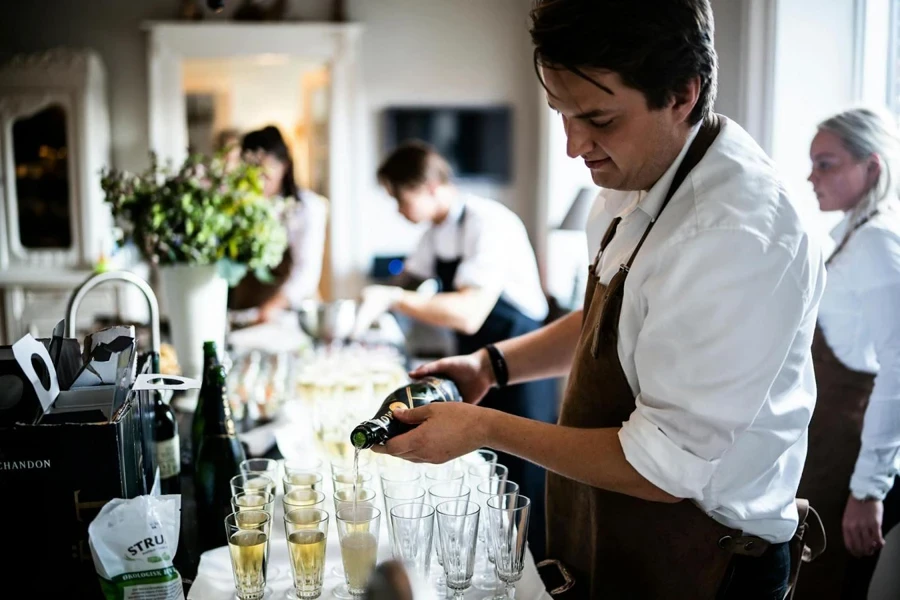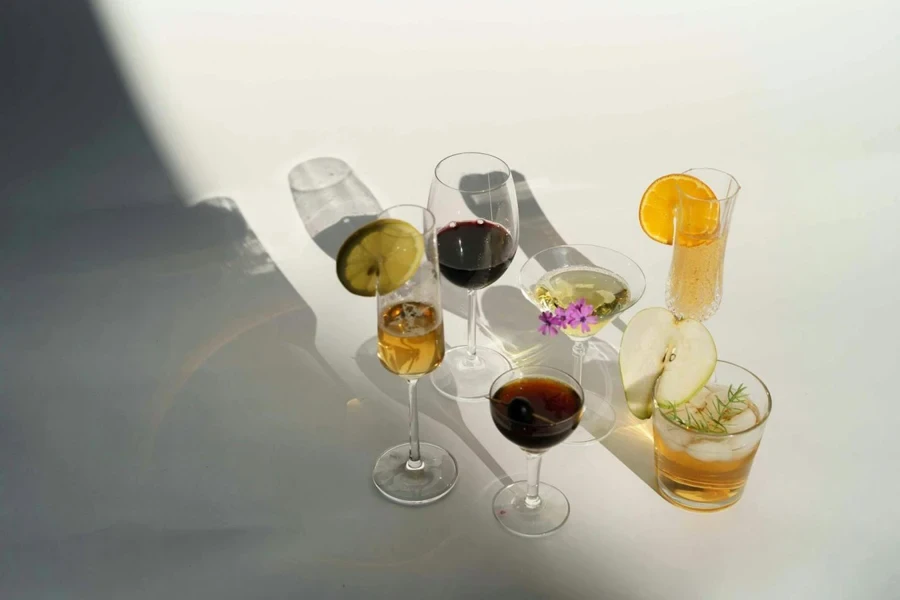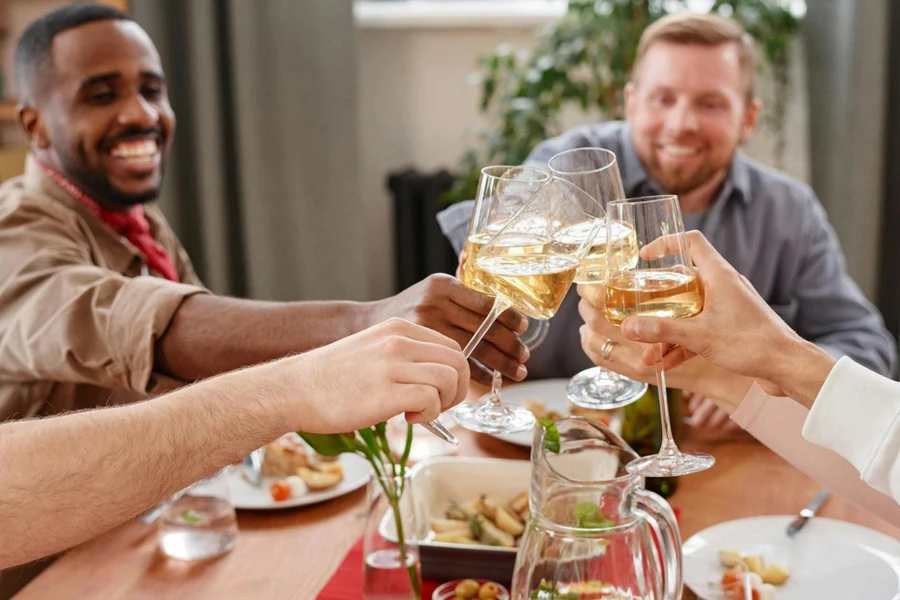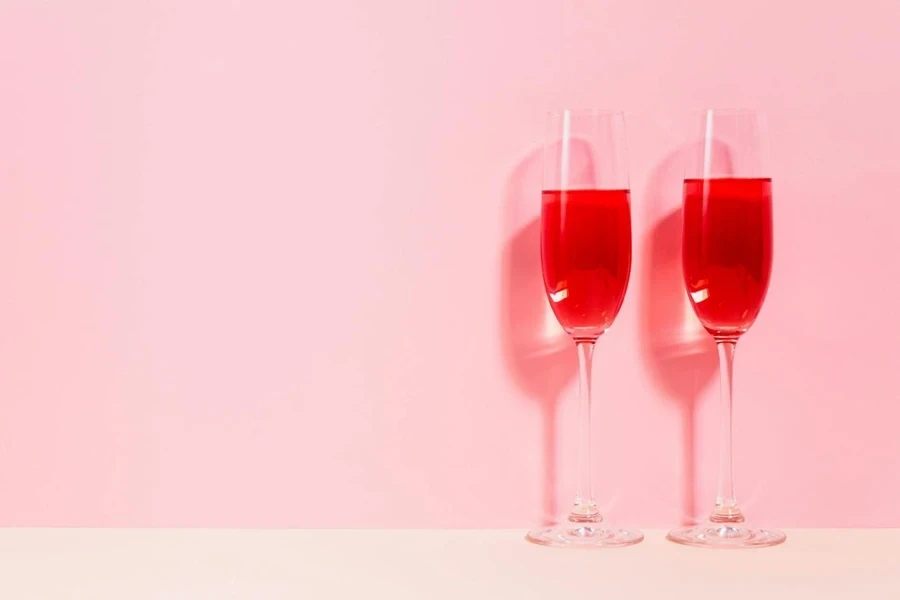Table of Contents
● Introduction
● Market overview
● Key design and material innovations
● Top sellers driving market trends
● Conclusion
Introduction
The right champagne glass can elevate the sparkling wine experience, making each sip more enjoyable and memorable. Market dynamics reveal the current market scale, growth rate, and major players in the champagne glass industry, highlighting significant shifts and emerging trends. Innovative designs and materials play a crucial role in enhancing the drinking experience, with particular attention to bubble retention, aroma concentration, and visual appeal. Top-selling glass types are influencing current market trends, reflecting evolving consumer preferences and driving new product developments. Ultimately, selecting the perfect champagne glass for any occasion adds a touch of sophistication and enhances every celebration.

Market overview
The champagne glass market has experienced notable growth, driven by increasing consumer interest in premium glassware. The market size is substantial, with estimates placing it at $500 million globally according to Market Research Future. A significant factor in this growth is the compound annual growth rate (CAGR), which has been reported to be around 5-7% over recent years. Major players in the industry, holding significant market shares, are continuously innovating to meet the evolving demands of consumers. These innovations often focus on enhancing the aesthetic appeal and functionality of champagne glasses, which are key factors influencing purchasing decisions. The market’s expansion is also attributed to rising disposable incomes and the growing popularity of champagne as a beverage for special occasions and celebrations.
Market changes highlight significant shifts in consumer preferences and purchasing behaviors. There is an evident trend towards glasses that not only serve their basic function but also enhance the overall champagne drinking experience. According to Market Research Reports Inc., the global champagne glass market is expected to continue its upward trajectory, driven by a 4.5% CAGR from 2023 to 2029. This growth is supported by an increasing demand for crystal glassware, which is valued for its superior clarity and durability. Additionally, the market is responding to a rising consumer interest in sustainable and eco-friendly materials, influencing manufacturers to incorporate recycled materials and adopt greener production methods. The trend towards glasses designed to improve bubble retention and aroma concentration is also prominent, as these features are critical for champagne enthusiasts. These evolving preferences are shaping the development of new products and the strategic direction of leading brands in the champagne glass industry, ensuring continued market growth and innovation.
Key design and material innovations
Shape and design
Different glass shapes significantly impact the champagne drinking experience. Flute glasses, known for their tall and narrow shape, are designed to preserve carbonation and focus bubbles at the center. However, according to G.H.Mumm, they may limit the wine’s ability to express its full aromatic profile. Coupe glasses, with their wide and shallow bowls, offer a vintage appeal but cause bubbles to dissipate quickly, losing essential aromas. Tulip glasses strike a balance with a wider bowl that tapers at the top, allowing for better aroma concentration and bubble retention. Trumpet glasses, a modern take, feature a flared top that enhances aroma release while maintaining some carbonation. The choice of shape affects not only the sensory experience but also the visual presentation of the champagne.
Material innovations
The material of champagne glasses plays a crucial role in enhancing the drinking experience. Crystal glassware, as highlighted by Liquor.com, is preferred for its superior clarity and ability to transmit the intricate details of champagne. Crystal can be crafted thinner than regular glass while maintaining durability, which enhances the tactile experience and the wine’s visual appeal. Moreover, crystal glasses often include design elements that improve functionality, such as etched points at the base to encourage continuous bubble formation. While glass is a common alternative, it typically lacks the same level of sophistication and sensory enhancement provided by crystal.
Functional enhancements
Several features have been developed to improve the sensory experience of drinking champagne. According to thinKitchen, one of the most critical aspects is bubble retention, which is influenced by the glass’s shape and etching. Glasses designed with a narrow base and wider bowl, like tulip and trumpet shapes, allow bubbles to rise and burst at the optimal rate, enhancing the aromatic delivery. Aroma concentration is another key factor, with tulip glasses offering the best balance by allowing aromas to gather and be funneled towards the nose. Durability is also a consideration, particularly for high-end crystal glassware that must withstand frequent use and handling. Innovations in glass production, such as lead-free crystal and reinforced stems, contribute to a more resilient product without compromising on elegance.

The role of crystal in champagne glasses
Crystal glassware stands out in the market due to its ability to enhance the overall sensory experience of champagne. According to sources, crystal glasses offer unmatched transparency and brilliance, making them the preferred choice for champagne enthusiasts. The production of crystal glassware involves creating extremely thin yet durable glasses, which contribute to a more refined drinking experience. Crystal’s ability to maintain clarity and resist clouding over time ensures that each glass maintains its visual appeal. Additionally, the tactile sensation of drinking from a crystal glass, combined with its aesthetic qualities, elevates the enjoyment of champagne.
Enhancing the champagne experience
Understanding the impact of glass design and material on the champagne drinking experience allows for more informed choices. Selecting glasses with optimal shapes, such as tulips and trumpets, can significantly enhance aroma concentration and bubble retention. The use of crystal as a material further amplifies the visual and sensory aspects, making each sip more enjoyable. Functional enhancements, including bubble-etching and reinforced stems, add to the durability and effectiveness of champagne glasses. By considering these factors, consumers can choose the perfect glass to elevate their champagne experience, ensuring every celebration is marked by sophistication and enjoyment.

Top sellers driving market trends
Popular glass Types
Current best-sellers in the champagne glass market encompass a range of styles, each catering to different preferences and occasions. According to The Champagne Company, flute glasses remain popular due to their ability to preserve carbonation and concentrate bubbles, making them ideal for formal events. Variations such as classic flutes, trumpet flutes, and stemless flutes offer consumers options based on their aesthetic preferences and functionality needs. Coupe glasses, known for their vintage charm, are favored for celebratory toasts and creating champagne towers despite their tendency to dissipate bubbles quickly. Tulip glasses, appreciated for their wider bowls and narrow openings, provide a balanced experience by enhancing aroma concentration while maintaining bubbles, making them a top choice for connoisseurs.

Consumer preferences
Consumer preferences for champagne glasses are influenced by both functional and aesthetic considerations. Flutes are preferred for their elegance and ability to keep champagne effervescent, which is crucial for maintaining the festive feel of the drink. The classic design is often chosen for formal settings and large gatherings due to its practicality in serving multiple guests efficiently. Coupes, despite their less efficient bubble retention, are selected for their historical and aesthetic appeal, often used in themed parties and events that seek a retro vibe. Tulip glasses have gained popularity among serious champagne drinkers and sommeliers who value the enhanced aroma and flavor profile that these glasses offer. According to thinkKitchen, the preference for tulip glasses reflects a trend towards more immersive and sensory-driven champagne experiences.
Market influence
Top sellers in the champagne glass market significantly influence trends and drive the development of new designs and materials. As flute glasses dominate sales, manufacturers continue to innovate within this category, introducing variations that cater to modern tastes and usage scenarios, such as stemless and trumpet flutes. The resurgence of coupe glasses has prompted a revival in vintage-style glassware, blending classic designs with contemporary production techniques to improve durability and functionality. Tulip glasses, favored for their sensory benefits, are shaping the market towards more specialized glassware that enhances the overall drinking experience. According to Liquor.com, the market is also seeing a shift towards sustainable materials, with an increasing number of consumers seeking eco-friendly options without compromising on quality and aesthetics.
Functional trends
The functional aspects of champagne glasses are evolving to meet the sophisticated demands of modern consumers. Glasses with etched points at the base, for instance, are designed to enhance bubble formation, adding to the visual and sensory appeal of the champagne. Crystal glasses, valued for their clarity and thinness, continue to be preferred over regular glass due to their superior tactile and aesthetic qualities. Innovations in glass production, such as lead-free crystal and reinforced stems, are making high-end glassware more durable and accessible. According to The Champagne Company, these functional enhancements not only improve the drinking experience but also reflect a broader trend towards luxury and refinement in consumer choices.
Design innovations
Design innovations in champagne glasses are largely driven by consumer preferences and market trends. The demand for glasses that enhance the sensory experience of champagne is leading to more varied and sophisticated designs. Flute glasses, for instance, are now available in a range of styles that cater to both traditional and contemporary tastes. The popularity of tulip glasses is pushing designers to create shapes that maximize aroma concentration and bubble retention. Coupe glasses are being reimagined with modern materials and production techniques to combine vintage aesthetics with improved functionality. These innovations reflect a market that is both responsive to consumer demands and proactive in exploring new possibilities for enhancing the champagne-drinking experience.

Conclusion
Choosing the right champagne glass involves understanding market trends, innovative designs, and popular products. Market preferences indicate a strong inclination towards flute glasses for their ability to preserve carbonation and maintain elegance in formal settings. Tulip glasses are favored for their balanced design that enhances both aroma and bubble retention, making them ideal for connoisseurs. Coupes, with their vintage charm, are often selected for their aesthetic appeal in celebratory settings. Each glass type caters to different aspects of the champagne experience, from the visual presentation to the sensory impact.
By selecting an ideal glass, such as a flute, tulip, or coupe, the champagne experience can be significantly elevated. The choice of glass not only influences the sensory qualities of the champagne but also enhances the overall enjoyment of each celebration. Understanding these trends and innovations allows for an informed decision, ensuring that each toast and sip is experienced to the fullest.




